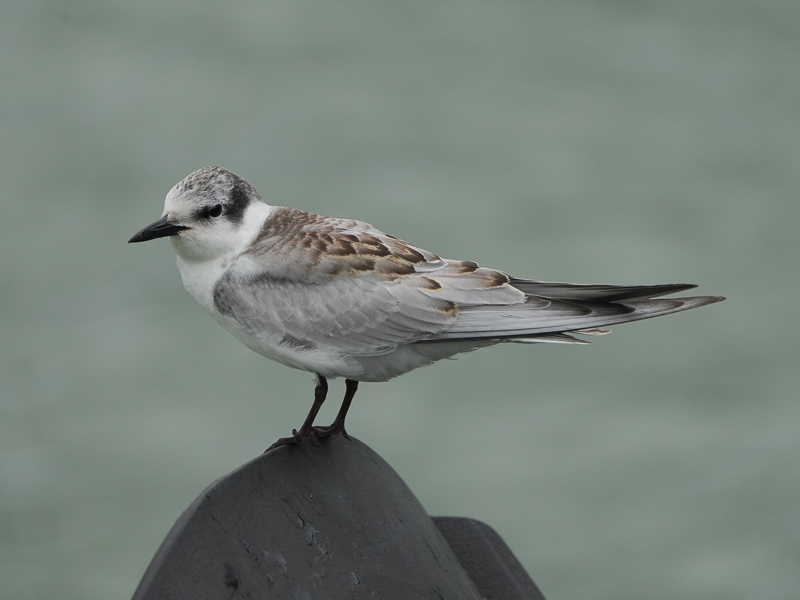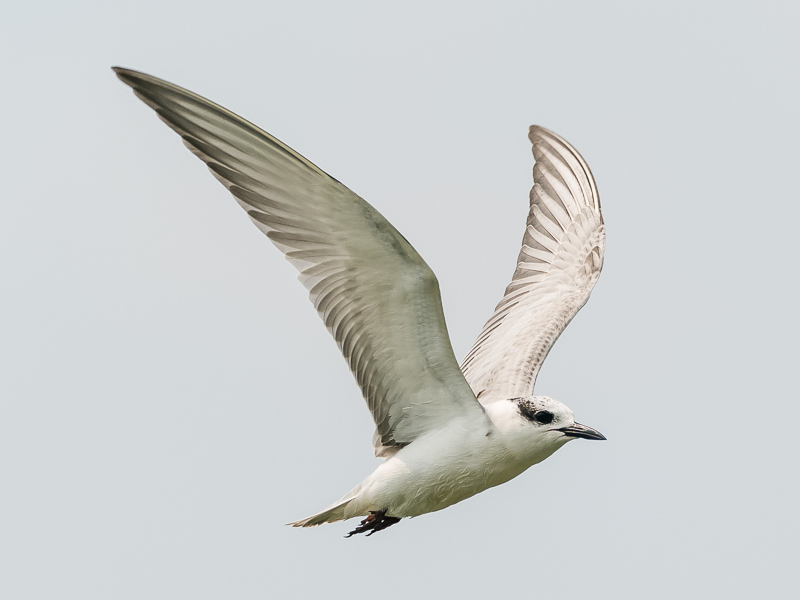Whiskered Tern Chlidonias hybrida 鬚浮鷗
Category I. Common passage migrant, scarce in winter; occurs mainly in fish pond and freshwater wetland areas, but also in inshore and, occasionally, offshore waters.
IDENTIFICATION

May 2022, Paul Leader. Adult breeding plumage.
24-28 cm. Differs from Sterna terns in being slightly smaller and in having shorter, less pointed wings and a short tail with a shallow fork and a less powerful flight. Rarely plunge-dives. Differs from White-winged Tern in being larger, with larger bill and less agile flight. In breeding plumage the upperparts are rather uniform greyish.

Apr. 2020, John and Jemi Holmes. Adult breeding plumage.
In flight the pale underwings contrast with the grey body and white chin and lower face contrasts markedly with the black crown and greyish underparts. The bill is deep red.

Oct. 2022, Paul Leader. Juvenile.
Juvenile plumage distinguished from that of White-winged Tern by the less rounded ear patches, coarsely patterned brown mantle and lack of white on rump. Can be similar to juvenile Common Tern but distinguished by lack of obvious carpal bar, all-dark bill, broader dark chevrons on mantle feathers and less solid black on crown.

Apr. 2020, Kenneth Lam. Second calendar-year.
In winter plumage upperparts are uniform pale grey with blackish band behind eye that extends to nape and does not drop down behind the eye and darker streaking on crown. The worn outer six primaries indicate this bird is in second calendar-year plumage, as does, given the date, the lack of breeding plumage.
VOCALISATIONS
Typical flight calls when foraging are dry and rasping (‘kerk’, ‘krik’, ‘krrrk’), lower in pitch and harsher than those of White-winged Tern.
DISTRIBUTION & HABITAT PREFERENCE
Most records are from the Deep Bay area where birds are seen mainly in the fish pond areas, though also on Mai Po NR and in Inner Deep Bay. Inactive fish ponds with open water appear to be favoured. Smaller numbers occur at inshore localities such as Shuen Wan, Tolo Harbour and Channel, and to a lesser extent in offshore waters. Most of the latter records occur in spring when passage has been noted from Po Toi and the ferries serving the island.
OCCURRENCE
There were no reports in either January or February between 1976 and 1995, at which time Whiskered Tern was considered almost exclusively a passage migrant from mid-March to May and from mid-August to the first week of December. It now regularly, if rarely, occurs midwinter. Up to four birds have been recorded from the second half of December to the end of February in most winter periods since 2010. It is possible this is due to milder winters as a result of global warming.
Spring passage is certainly evident from the last week of March and is strongest from the last week in April to the middle of May (Figure 1). The highest spring count is of 138 migrating over the sea near Po Toi on 12 May 2007, while the highest count at more typical sites is 128 at San Tin fish ponds on 7 May 2019.
Numbers decline sharply after the middle of May, but a trickle of birds occur to mid-June. Midsummer records occasionally occur, usually one or two birds apart from a high count of 22 birds made during a survey of a large area of sea on 20 June 2020.
Autumn passage is evident from at least the last week of August but is rather weak until mid-September, the beginning of the peak passage period, which lasts to month end. The highest autumn count is 250 at San Tin fish ponds on 17 September 2014. Numbers then decline and records after the end of October are unusual.
In the 1990s Whiskered Terns were more regular and more numerous than previously; however, this was considered by Carey et al. (2001) to be due to increased observer activity and reporting. The even higher numbers occurring this century (Figure 1) appear to be so large that it cannot be explained by the increase in observer coverage that has occurred.
BEHAVIOUR, FORAGING & DIET
Flies back and forth over water surface before swooping or dropping down to take prey from at or just below surface of water, including small fish.
Gregarious, flocks passing through on both spring and autumn passage. In autumn in particular, flocks may frequent for a few weeks fish pond areas where they forage in small groups across the area. Habitually roosts on wires over ponds.
RANGE & SYSTEMATICS
Breeds in scattered areas from southern Europe east to southern Kazakhstan and in northeast China and adjacent parts of Russia and Mongolia; winters in north Africa, the Indian subcontinent, Indochina, southeast Asia and Indonesia to New Guinea. Resident populations occur in south Africa and Australia (Gochfeld et al. 2020). In China a summer visitor east, northeast and northwest areas (Liu and Chen 2020).
Of the three subspecies recognised the nominate breeds in the northern hemisphere and passes through HK. The remaining two subspecies occur in Africa (delalandii) and inland Australia (javanicus).
CONSERVATION STATUS
IUCN: Least Concern. Population trend stable.
Figure 1.

Carey, G. J., M. L. Chalmers, D. A. Diskin, P. R. Kennerley, P. J. Leader, M. R. Leven, R. W. Lewthwaite, D. S. Melville, M. Turnbull and L. Young (2001). The Avifauna of Hong Kong. Hong Kong Bird Watching Society, Hong Kong.
Chalmers, M. L. (1986). Annotated Checklist of the Birds of Hong Kong. Hong Kong Bird Watching Society, Hong Kong.
Gochfeld, M., J. Burger, G. M. Kirwan, and E. F. J. Garcia (2020). Whiskered Tern (Chlidonias hybrida), version 1.0. In Birds of the World (J. del Hoyo, A. Elliott, J. Sargatal, D. A. Christie, and E. de Juana, Editors). Cornell Lab of Ornithology, Ithaca, NY, USA. https://doi.org/10.2173/bow.whiter2.01
Liu, Y. and Y. H. Chen (eds) (2020). The CNG Field Guide to the Birds of China (in Chinese). Hunan Science and Technology Publication House, Changsha.

